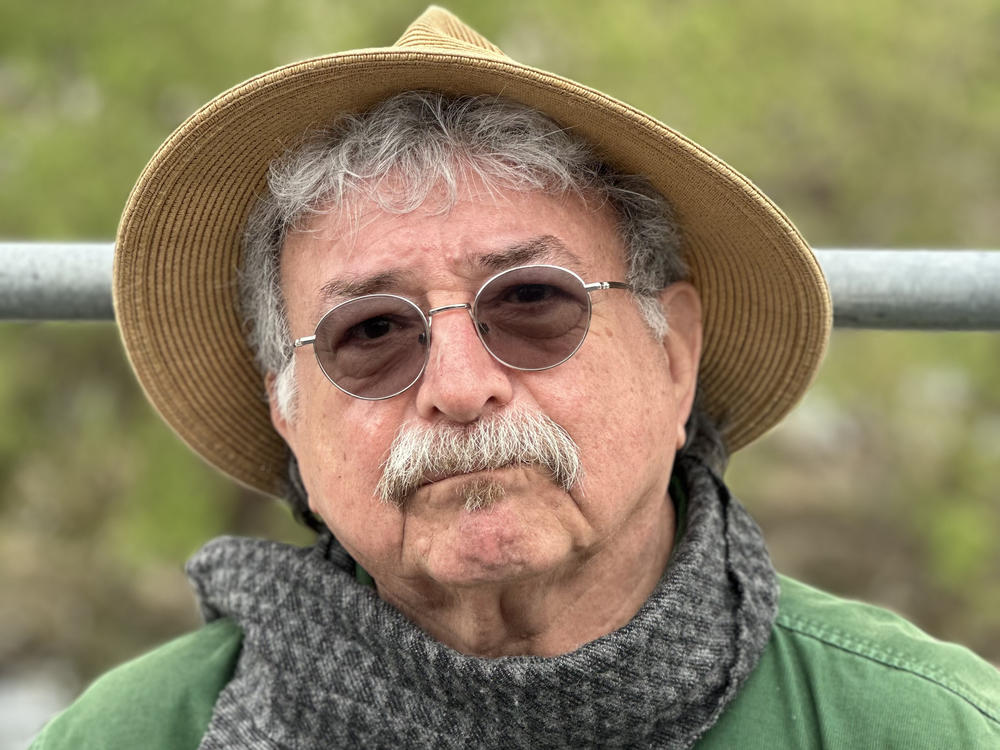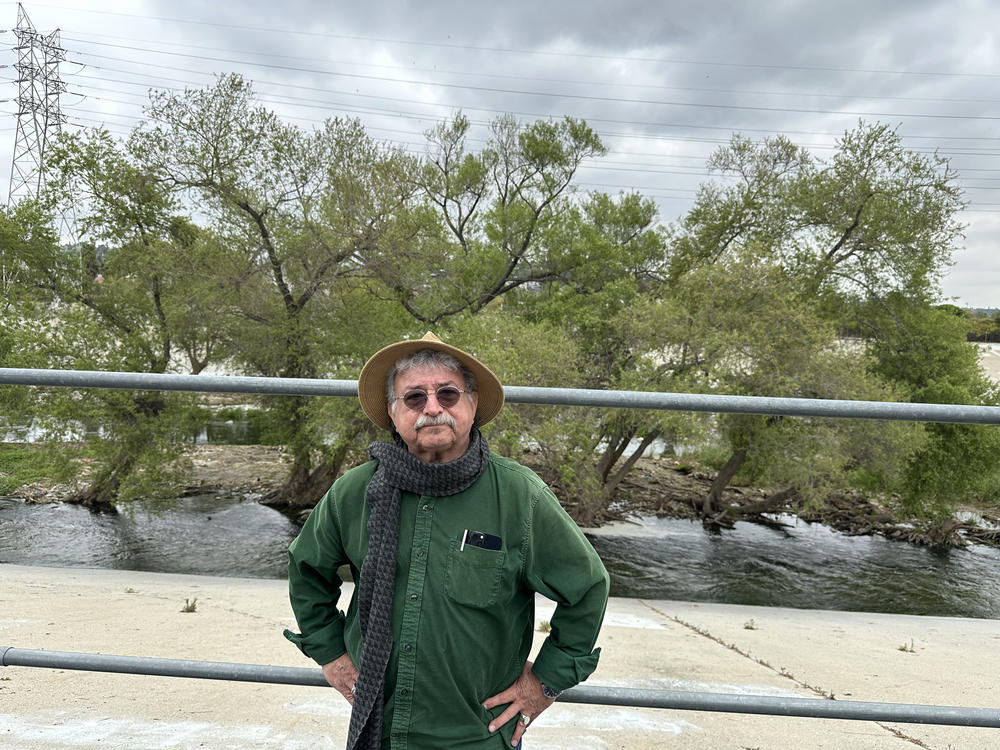Section Branding
Header Content
After chronicling California at 'L.A. Times' for 43 years, Louis Sahagún has retired
Primary Content
It was the early 1970s in Los Angeles, high-rises had begun to dot downtown, the city was a center of pop culture, music and film. A twenty-something Louis Sahagún had just dropped out of junior college and was looking for work when he came across an opening for a utility worker at the Los Angeles Times, the city's daily newspaper.
Sahagún got the job and swept the lead dust around the printing machines, but it was the environment of the buzzing newsroom that widened young Sahagún's eyes.
"Even the other utility men and women, the floor sweepers ... they were an exciting, incredibly diverse group of folks," he told NPR.
He recalls meeting an anarchist poet over lunch with fellow utility workers: "I was electrified by the idea that I worked shoulder to shoulder with a person like that."
The atmosphere inspired Sahagún to further his education, and eventually he worked his way up to becoming a staff writer at the L.A. Times for more than 43 years.
Over the decades, Sahagún established himself as one of the most recognizable bylines in California. He made his first appearances in the paper reviewing books, and went on to cover everything from politics, crime and religion to the environment and culture.
Having grown up in a working-class, farming family on a ranch in southeast Los Angeles, Sahagún has warm memories of the wilderness of L.A., which became a main character of many of his stories, whether they were about desert tortoises fighting their own disappearance, coyotes becoming the center of a heated political debate over property rights, or about environmental and housing battles surrounding the development around the L.A. River.
"Throughout my career, 43 years as a reporter, I've been chasing those diminishing scenes," Sahagún said of the places he grew up in in Southern California. "I developed internal marching orders decades ago to write articles that would take our readers to places they have never been."
In April, Sahagún finally retired from the L.A. Times.
NPR's All Things Considered met Louis Sahagún on the concrete banks of the Los Angeles River, a place he says is emblematic of the many development, water management and environmental battles the city and its residents have long faced.
This interview has been lightly edited for length and clarity.
Interview highlights
Louis Sahagún: It is a real river that's been straight-jacketed and concretized. And that occurred in 1938 after a historic flood. A lot of people died. A lot of property was destroyed as L.A. was burgeoning. And so the city fathers and the people who were moving in said, OK, this cannot ever happen again, and it won't because we got the U.S. Army Corps of Engineer to come in and cover it in concrete so that it'll rush storm water from here out to the ocean. So we wound up becoming, partly because of the safety that this infrastructure provided, one of the fastest-growing communities in the United States.
Ailsa Chang: You grew up in an area now called the Whittier Narrows, about 20 minutes southeast of here, right?
Sahagún: Yeah, it was teeming with wildlife. There were clouds of tadpoles. There were fleets of frogs leaping out of the grass. My uncles were shooting waterfowl and we were having them for dinner. There was cattle grazing. It was a major industry. Dense vegetation. The smell of mule fat was everywhere in the air — it's a kind of native plant that you find along river areas and streams in Southern California — and it has a peculiar smell. And whenever I smell mule fat, honestly, I get goosebumps because it takes me all the way back to the ranch [where I grew up] then known as El Rancho del Don Daniel.
Chang: And growing up on a ranch with your family in that area, how do you think that shaped your relationship with nature?
Sahagún: Those memories, all of that wildlife and all that natural kind of excitement, in kind of a way, throughout my career, I've been chasing those diminishing scenes. That was the thing that propelled me through it all was looking for patches, remnants of those memories. Where were they? How are they faring? What their fate might be in the way of more development?
Chang: Is there a moment or two in your career at the L.A. Times that you look back on most proudly or most fondly?
Sahagún: I had a major contribution to the first Pulitzer won by the Latino journalists. And that was in 1984. My contribution was a profile of the community of Boyle Heights. Our mission for that series was to turn the page to tell the real story of Latinos on the east side of this very river (the L.A. River), which was not just gangs and mayhem. We wrote a new trajectory, forevermore, [for] coverage of the Latino community of L.A. We laid the groundwork for a whole new understanding. I'm so proud of that.
Chang: I feel like every time I see some untold story about some corner of California that I have never heard of, I don't even have to look at the byline because I just know it's going to be your name at the top of that story. What is it about California that has kept you here for all these decades as a writer?
Sahagún: In part because I grew up with working-class Chicano parents. So in an odd way, I felt I was writing dispatches for people like those I grew up with, and I was taking them to places that I never got to go within the area. Like Owens Valley to remote corners of the Mojave. And, you know, these are things that my mom and dad, [they'd say] "Hey, read your story. Hey man, that was great." That was the applause I was looking for.
Chang: When you look back on your more than four decades writing about this state, what do you want your legacy to be?
Sahagún: The legacy is, if there is one, that I got to chronicle the tug of war between wildlife and humans in one of the largest and fastest growing and most influential regions of planet Earth. If nothing else, I'm very proud of that. And I want to give you an example of that struggle that I am proud of. It's not the longest story. It's not the most prize-winning, but when it comes to pride, it's this one: I got to tell the world that desert tortoises, they evolved when things were more moist, there was more water, and it was a wetter environment. And they adapted to the desert. Today, in the midst of historic drought, some female tortoises are laying more eggs than they are physiologically capable of laying without dying. It's a genetic Hail Mary pass into the future on behalf of the species that, if I think about it too much, I get tears in my eyes. Those female desert tortoises are my heroes. I got to tell the world about that. Yeah, I'm proud of that.
Chang: I can tell you still love to tell stories. What made you decide to leave the L.A. Times?
Sahagún: It's just time. There comes a time when, I believe, you have to step out of the way. You just should. And, you know, I have a book in mind.
Chang: What's your book about?
Sahagún: Well, I'll say this. It's going to be a unique take on the eastern Sierra Nevada and the mystics and gurus and hucksters who gravitated there, and whose influence lingers still in surprising ways.
Chang: Well, I wish you the best of luck, Louis.


